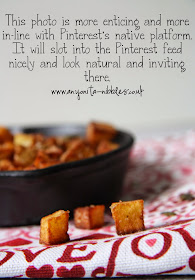Three Instant Ways to Make Your Content Pinnable
Written by: Anyonita Green onEnsure that your photos are pinnable.
Having a pinnable photo is of utmost importance because Pinterest is a visual platform that is photo heavy. One thing to remember about Pinterest is that, on the whole, it is meant to be an inspiring place where people collect ideas of projects they want to do, trips they want to take and food they want to eat. Your photos need to play into that as much as possible.
Even the most beautiful photo can fall flat with pinners if it doesn't have the earmarks of classic pinnable content. Here are a few things I've noticed over the last year or so about photos that perform well on Pinterest:
- 80% of my most re-pinned & pinned photos are bright & engaging
- photos that show the ideal situation perform better(ie: finished product vs. behind-the-scenes)*
- portrait photos perform much better than landscape photos**
**Portrait photos work better because Pinterest is designed in such a way to favor them. Think about the natural columns you'll see in your Pinterest feed: they're thin and long and photos that slot into these columns are more appealing than boxy square photos.
Take a look at these two photos:
Both are equally strong and would be considered to be good photographs. Here's what happens when they appear in a Pinterest stream:
 |
| Click the photo to see a larger version. |
 |
| Click the photo to see a larger version. |
Be sure to use alt tags.
I must have written six tutorials on the importance of using alt tags over the last few months! I can't stress it enough, guys; alt tags are the secret weapon for pinnable content. I'm not going to rehash everything I've previously said about them; I'll just recap two key points:
- Use alt tags to auto-fill your Pinterest pin descriptions & influence what pin descriptions say when pinned organically from your site
- Alt tags are beneficial for SEO
Be certain to leave succinct descriptions.
Even if your photo is stunningly beautiful and is a portrait shot and is bright and engaging, if it's not clear what your photo is meant to convey, your content will fall short.
The description on a pin is your place to tell a brief, relevant story about the pin: use it wisely! Convey any information that's pertinent and intriguing and that wasn't conveyed in the image itself. (Is it clear from the photo that you used coconut flour in those brownies? No? Say it in the description!)
Another way to be sure your description is hitting all the right notes and is working for your benefit is to use hashtags. Don't, I repeat, do not go over the top with the hastags. Hashtags should be used sparingly and within reason and to help to corral interested pinners and make them aware of your content. Let's say, I was pinning my portrait photo and wanted to use what I know about the importance of alt text to set my pin description.
Here are two examples of common pin descriptions:
#Pan-roasted #potatoes covered in #Mediterranean #salt with #rosemary #herbs in a #skillet on a #linen with #hearts that are #red and #pink. #yum #greatdinneridea #easymeals
Pan roasted #potatoes seasoned with Mediterranean salt and #rosemary. #glutenfree #vegetarian and #vegan #recipe
Which do you think is more important for the pin? Which do you think most closely relates to searches people are likely doing on Pinterest at the moment? I'm not sure how many people would be searching for "#linen with #hearts" but you can be certain that thousands are searching for "#glutenfree", "#vegetarian" and "#vegan".
While there's nothing wrong with the #greatdinneridea and #easymeals tags, that's the type of information that you could convey by pinning this photo to a board entitled Dinner Ideas or Easy Meals. When you use hashtags, especially on Pinterest, treat them like keywords: use ones that you have a chance of benefiting from. Every food blogger who shares dinners on Pinterest would claim that their recipe was a #greatdinneridea. The competition to gain traffic from that overly used hashtag would be fierce. So, instead, I opt for more niche, yet still relevant hashtags.
Here's the key to keeping a level head with Pinterest hashtags: use them to tell valuable, relevant information the viewer might have missed otherwise.
What tips do you have for pinnable content?














These are some great tips. I obviously need to work on my pinterest skills!
ReplyDeleteWhat a helpful post! Will be sure to put these points into practice.
ReplyDeleteVery helpful post on Pinterest. While I've read about the importance of a using portrait pictures versus landscape, I've never seen in displayed so cleverly and succinctly before. Thank you!
ReplyDeleteAww what a lovely comment, Meghan! :) Thank you!
DeleteThanks for the pinnable info. Pinned! ;)
ReplyDeleteYour blog tips are always helpful! Pinned and tweeted!
ReplyDeleteAnyonita, Is the proper way to have a business pinterest page, to go to your own blog, "pin" your pictures to your OWN pinterest page? I did it, and it worked...but something doesn't seem right about that! haha.
ReplyDeleteHi Sandy,
DeleteYou definitely want to pin that way. There's nothing wrong about it, all you're doing is sharing your great blog content on another platform. When you publish a post, do you share it on Facebook? Tweet about it? Pinterest is the same. I have a board dedicated to my blog and I pin to it every time I post. The way I balance it, is to make sure I don't have multiple boards filled with my own content; it's a very small percentage of what I pin each day.